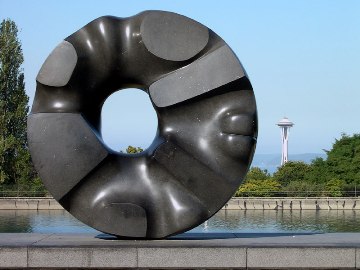As the most touched, caressed, and fondled piece of public art in Seattle, I would nominate Black Sun, installed at the old SAM (now SAAM) on Capitol Hill back in 1969. Hard to remember now, but American-born sculptor Isamu Noguchi (19041988) was once considered a rather daring modernist, an avant-garde cohort of Calder, Giacometti, and Rivera. Placing the big black circle directly in front of the 1933 Deco-influenced museum design (by the UWs Carl F. Gould)in an Olmsted park, no less!seemed a bit of a slap at convention. Such temerity! How did it fit with the collection, with the prevailing conservative orthodoxy of the citys tastemakers and benefactors? But Noguchi, with his American mother and Japanese father, was all about contradictionsor resolving them. He trained in New York and Japan. His abstract pieces drew inspiration from natural forms, but he was also an urbanite who designed opera sets. Though Black Sunexpanded on commission to nine feet in diameter from a similar earlier pieceis sited in the city, its an emphatic reminder of the water and other natural shaping agents that surround us. The granite, quarried in Brazil and hewn in Japan, offers a famous donut-hole view of the Space Needle, which was still new when the sculpture was lowered (off center) onto its plinth. Tourists love to frame photos through that peephole, looking west (across the ocean to Japan, where Noguchi worked and traveled). But reverse that perspective and youre looking east, back at Goulds museum, whose design and collection were then mostly European. Black Sun is an aperture, a transitional portal between traditions of seeing and collecting art. Certainly it marked a change in Seattles appreciation for sculptures that didnt depict white men on horseback. Whether Soundgardens Black Hole Sun is named for the disc is something youll have to ask Chris Cornell. BRIAN MILLER
Starts: Oct. 8. Daily, 6 a.m., 2008




